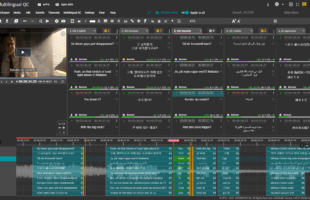Image from Freepik.com
This story appears in the March-April 2021 issue of Television Asia Plus.
Amazon Web Services (AWS) CTO, Werner Vogels recently predicted that this year, the cloud would become ubiquitous. In the media and entertainment (M&E) industry, as demand for content increases and consumers shift between platforms faster than ever, businesses have already embraced cloud technology, including the use of AI and machine learning, to enable remote production and distribution of content, providing an enhanced customer experience at scale.
With cloud technology becoming accessible to businesses of all sizes, and customers demanding a seamless experience across platforms, media companies are now looking to unify their workflows for broadcast and digital. In doing so, these companies are achieving increased efficiencies across content acquisition and processing as well as in content distribution. As the benefits of cloud-based workflows become apparent during the pandemic, the use of cloud technology will last beyond it.
Production workflows going virtual on the cloud
M&E businesses needed a way to accelerate the production and delivery of new content as demand spiked during the pandemic. The creation of visual effects is resource-intensive, with artists needing dedicated, powerful workstations. However, because of social distancing, artists were unable to access the tools they needed to work. By using cloud-based virtual workstations for Visual Effects (VFX), animation, and video editing workflows, production studios can provide their artists with access to the computing power they need for creating images, rendering video, and storing assets.
For example, using AWS, Method Melbourne, the Australian branch of global visual effects company Method Studios, was able to meet the demanding VFX requirements for the movie Jumanji: The Next Level. The company created 164 out of the 280 VFX shots the project required with the cloud, scaling up the render capacity of its internal, 10,000-core farm by four times. This cloud-based approach allowed artists to explore more creative iterations with faster rendering while helping the company control its licensing costs.
Going on the cloud
Traditional M&E companies, including broadcasters, are now transforming to go beyond satellite and cable distribution to reach new audiences. These companies have adopted mobile streaming options and on-demand service models to distribute highly localized content, mirroring how OTT platforms operate.
By adopting a single cloud platform for their OTT services, M&E companies can leverage prebuilt solutions that help speed up development, instead of coding from scratch. They can focus on content and marketing, while the cloud service provider manages storage, compute, and other infrastructure requirements.

Because cloud solutions are scalable, businesses can provide high-quality digital experiences at scale, while only paying for the infrastructure in use with customer influxes. Businesses can also go global in minutes by ingesting video near the content owner and serving video close to the audience. The time to market for a product is vastly reduced, providing businesses with greater flexibility than they would have with on-premise infrastructure.
As an example, Astro Malaysia started its digital transformation with AWS in 2017 and today has over 10 petabytes of its content on AWS. In 2020, the company launched an enhanced video experience for its subscribers using AWS Partner Synamedia’s Infinite solution on AWS, and its subscribers now have access to IP-enabled UHD set-top boxes with a new, enhanced UX as well as access to Synamedia Cloud DVR.
Cloud technology has also changed the dynamics between companies in the M&E industry. Pay-TV and telecom operators are actively collaborating with OTT service providers—who are perceived as their competitors—to provide a combined, more compelling content offering to their audiences.
Channel production and playout in the cloud
Consumers today have the freedom to shift between platforms, including PC and mobile, faster than ever. There is also increased demand for localised content across these platforms. Consumer expectations, including factors such as personalisation and latency, are at an all-time high.
Using the cloud, broadcasters can deliver reliable, broadcast-quality video and offer world-class media experiences without the time, effort, and expense required to run specialized video equipment in a traditional data centre. Broadcasters now have the ability to launch and decommission live channels any time they want, making it possible to test new markets without worrying about the costs associated with such experiments in an on-premises environment.
AWS partner Amagi, which offers cloud-based playout solutions, is now streaming 400 channels globally, up from the two linear channels it hosted in 2014. The company has added about 150 streaming channels in the last year alone.
While pandemic-induced constraints forced many broadcasters to switch to remote live production in 2020, the industry is beginning to fully realize the reliability and scalability of cloud-based production. With the ability to leverage talent from anywhere in the world, while experimenting with new content formats and enhancing their audience reach, remote production capabilities are now a key part of an M&E business’ production strategy.
About the author:
Shweta joined Amazon Web Services (AWS) in January 2018 and heads the business development for its Media & Entertainment business across APAC. With two decades of industry experience across broadcasting and digital media, Shweta brings insight and capability to the growing APAC media customer base to help them harness the power of AWS, using the world’s broadest range of services, including compute, storage, databases, networking, analytics, media services, and machine learning.
Prior to joining AWS, Shweta was at New Delhi Television Ltd, a pioneer in India’s news television and digital media, where she double hatted as their Senior Vice President, Software Solutions, overseeing broadcast workloads, automation, and enterprise IT applications, and as the Founder Managing Director of a digital business in the content discovery and recommendations space.








